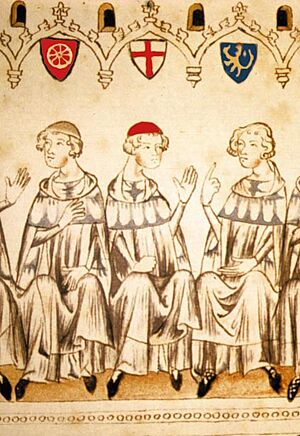Rudolf I, Duke of Bavaria facts for kids
Quick facts for kids Rudolf I "the Stammerer" |
|
|---|---|

The Prince-electors voting for Henry VII: Rudolf on the right, identified by the Palatinate Lion; excerpt from the Chronicle of Henry VII (Balduineum), 1341
|
|
| Duke of Upper Bavaria Count Palatine of the Rhine |
|
| Reign | 2 February 1294 – 1317 |
| Predecessor | Louis II, Duke of Bavaria |
| Successor | Louis IV, Holy Roman Emperor |
| Born | 4 October 1274 Basel, Prince-Bishopric of Basel |
| Died | 12 August 1319 (aged 44) Kingdom of England(?) |
| Spouse | Mechtild of Nassau |
| Issue |
|
| House | House of Wittelsbach |
| Father | Louis II, Duke of Bavaria |
| Mother | Matilda of Habsburg |
Rudolf I of Bavaria, also known as "the Stammerer," was an important duke from the Wittelsbach family. He was the Duke of Upper Bavaria and Count Palatine of the Rhine from 1294 until 1317. He was born on October 4, 1274, and passed away on August 12, 1319.
Contents
Rudolf's Early Life
Rudolf was born in Basel. His father was Duke Louis II of Upper Bavaria. His mother was Matilda of Habsburg, who was the daughter of King Rudolf I of Germany.
His father, Louis II, ruled over two areas: the Electoral Palatinate and Upper Bavaria. He lived in Munich and Heidelberg Castle. Rudolf's uncle, Duke Henry XIII, ruled over a different area called Lower Bavaria. This division of land happened in 1255.
Becoming a Duke
When his father died in February 1294, Rudolf became the Duke of Upper Bavaria. He was the oldest son who was still alive.
In September 1294, Rudolf married Mechtild of Nassau. She was the daughter of King Adolf of Germany. This marriage helped Rudolf's family gain more power.
Challenges with Kings
King Adolf, Rudolf's father-in-law, faced problems with other powerful leaders called Princes. In 1298, King Adolf was removed from power. The Princes chose Albert of Austria to be the new king. Albert was Rudolf's uncle.
Rudolf supported his father-in-law, King Adolf, in a battle against his uncle Albert. Albert won the battle, and King Adolf was killed.
After this, Rudolf joined King Albert's side. However, King Albert wanted more power for his own family. This caused new arguments within Rudolf's Wittelsbach family.
In 1301, King Albert made Rudolf accept his younger brother, Louis IV, as a co-ruler. Louis IV would later become a very important emperor. King Albert even attacked Rudolf's home in Heidelberg to make him agree.
Rivalry with His Brother Louis
When King Albert was killed in 1308, both Rudolf and Louis wanted to become the next king. But the Princes chose a different person, Henry VII from the Luxembourg family.
Rudolf voted for Henry VII. In 1310, Rudolf went with King Henry on a trip to Italy. However, Rudolf had to leave early. This was because new arguments started between him and his brother Louis IV. They were fighting over who should get more land and power in their family. This led to a civil war.
Peace and New Conflicts
Finally, on June 21, 1313, Rudolf and Louis made peace in Munich. Rudolf kept the Electoral Palatinate. This agreement allowed Louis to become the German king when Henry VII died.
Louis was elected King of the Romans in Frankfurt on October 20, 1314. Rudolf was not happy about this. He voted against Louis and supported another ruler, Frederick of Habsburg.
Because of this, Louis attacked Rudolf's lands in Bavaria and the Palatinate. Rudolf was forced to give up his rule to Louis in 1317. He agreed to do this until the fight with the Habsburg family was over.
A historian named Johannes Aventinus wrote that Rudolf went to England. He died there two years later. Rudolf later got the nickname "the Stammerer" because of his many difficult fights against his younger brother.
Rudolf's Legacy
In 1328, Louis IV became the Holy Roman Emperor. In 1329, he signed the Treaty of Pavia. This treaty gave the Electoral Palatinate to Rudolf's sons, Rudolf II and Rupert I. It also went to Rudolf's grandson, Rupert II.
Because of this, Rudolf I and his grandson Rupert II became the ancestors of the older branch of the Wittelsbach family. This branch later returned to power in Bavaria in 1777.
Family and Children
Rudolf married Mechtild of Nassau on September 1, 1294. She was the daughter of King Adolf of Germany. They had the following children:
- Ludwig (born 1297 – died before 1311)
- Adolf, Count Palatine of the Rhine (born 1300 – died 1327). He married Countess Irmengard of Oettingen in 1320.
- Rudolf II, Duke of Bavaria (born 1306 – died 1353). He married Anne of Gorizia-Tyrol in 1328. Later, he married Margaret of Aragon in 1348.
- Rupert I, Elector Palatine (born 1309 – died 1390). He married Elizabeth of Dampierre in 1328. Later, he married Beatrice of Jülich in 1385.
- Mathilde (born 1312 – died 1375). She married Count John III of Sponheim in 1330.
- Anna (born 1318 – died 1319).

